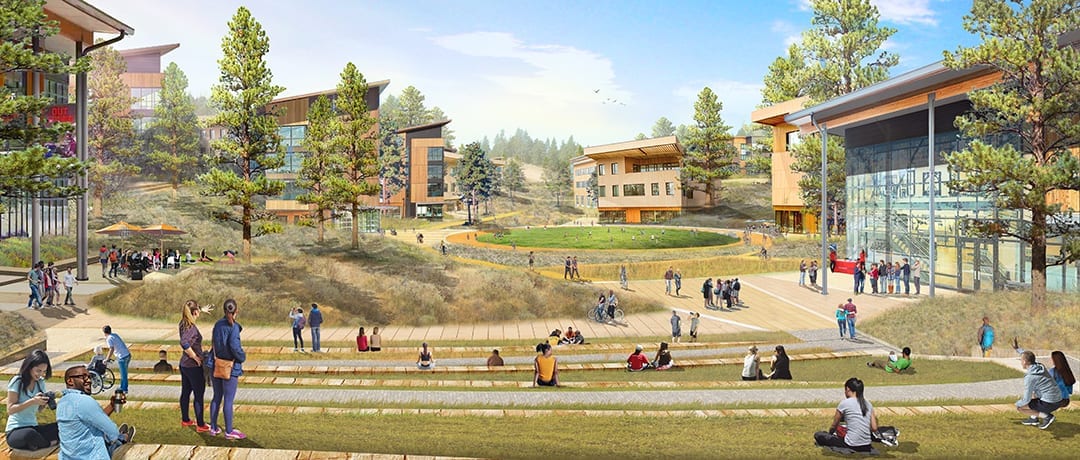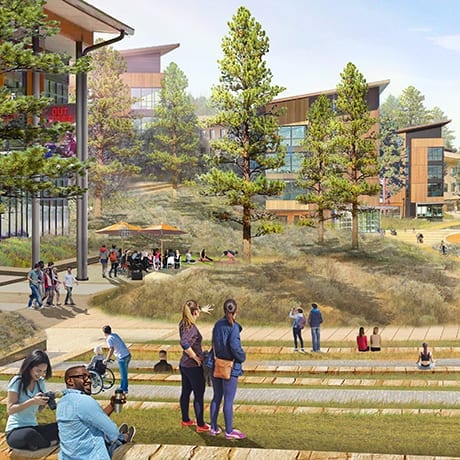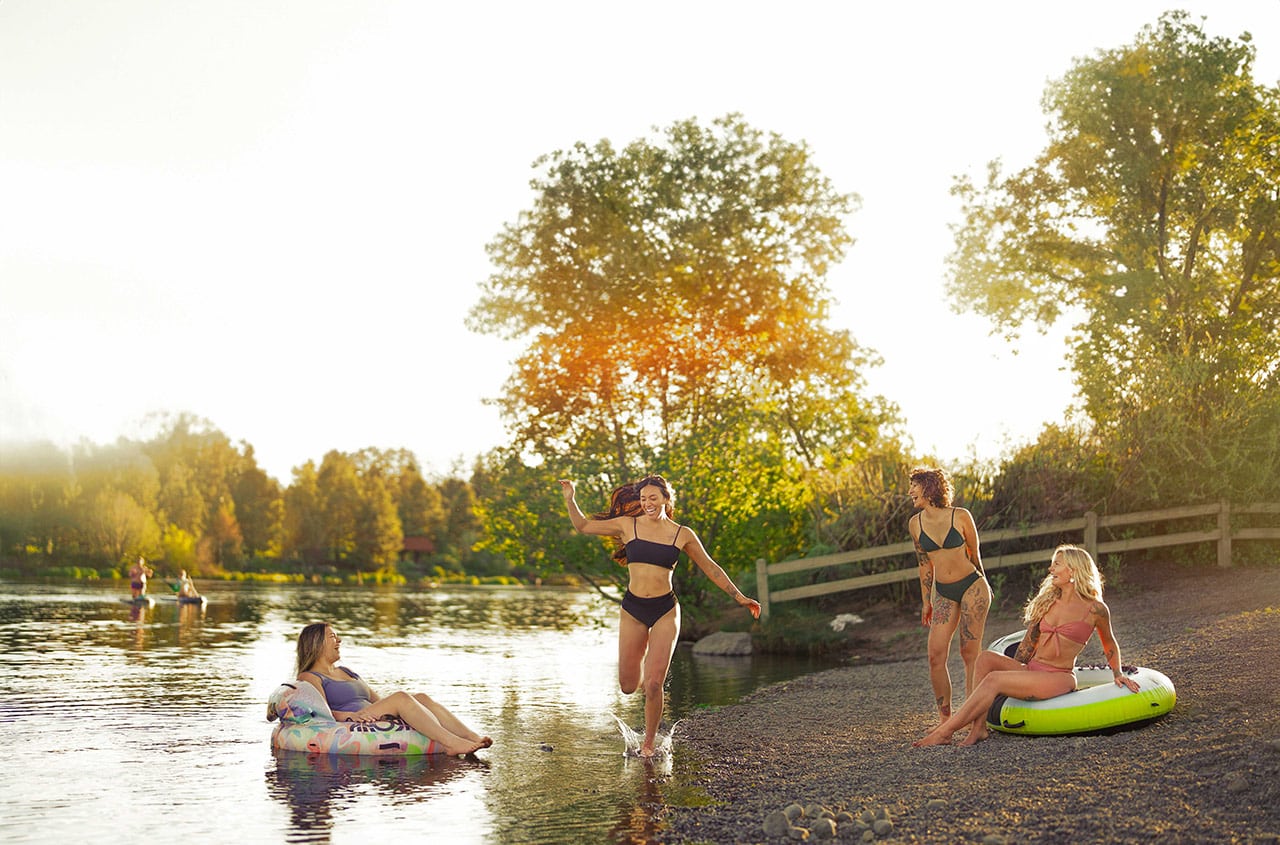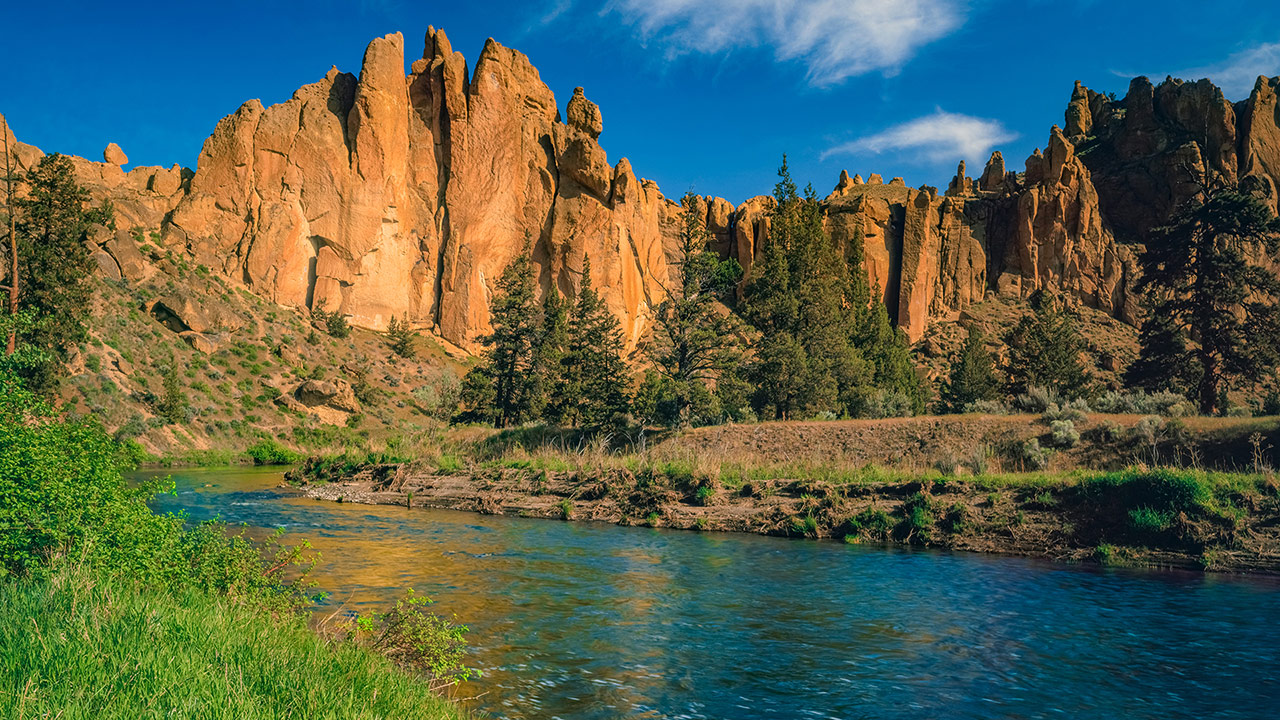The year is 2040. You drive through Bend, population 150,000, following signs to the local campus of Oregon State University.

OSU-Cascades officially opened its doors in 2001, holding classes on the Central Oregon Community College campus. In 2015, the university broke ground on a permanent home on the west side of Bend, despite opposition from neighbors concerned about traffic and an already crowded housing market. Many Bend residents had barely glimpsed the 128- acre site, which housed an old landfill and 100-foot-deep pumice mine, long cordoned off by chain-link fences and berms. The campus got final approval for its long range development plan in the middle of 2018. Here’s a peek at its future.
- If you want to visit the campus, go to 1.
- If you want to visit the surrounding area of Bend, go to 2.
1. Visit OSU-Cascades Campus
Zip around a series of new roundabouts to arrive on campus. Watch out for bikes! Especially the electric ones now preferred by students and faculty. They zoom along bike lanes and paths to avoid traffic jams, occasionally using the boost of an electric engine to arrive at class without breaking a sweat or burning a drop of fossil fuels.
Park your car or dock your bike and take a moment to look around. Forget about ivy-covered brick walls, this is not that kind of college.
It is “a really beautiful campus with lots of space for people to access, whether walking your dog or taking a bike ride or coming for a lecture or maybe some music event,” said Becky Johnson, vice president of OSU-Cascades. “We’re specifically designing it so it invites people on campus.”
A total of over ten miles of soft trails and paved bike paths zig zag across the campus, which is quiet despite the steady stream of students and joggers. The low-slung, modern-style buildings, all clad in neutral colors, recede into the sagebrush and ponderosas.
Population growth in Central Oregon has far outpaced student enrollment. Kelly Sparks, associate vice president for finance and strategic planning, estimated in 2018 that a new building would be constructed every couple of years, as 200 to 300 more students join the ranks. And Julie Gess-Newsome, dean of academic affairs, said that for the first decade or so, two to five new academic programs would be added each year. So even as the campus master plan was approved in 2018, officials didn’t know exactly what each building in the plan would be used for—or even what topics the students and faculty inside would be studying.
In the heart of the development is the quiet academic core of the university. Because the site is terraced, these buildings appear from the edge of campus to be just one story tall, even lower than the private developments across Chandler Avenue.
A young woman in an orange OSU-Cascades T-shirt is walking backwards and speaking to a tour group. She motions for you to join them.
- If you want to join a tour for prospective students, go to 3.
- If you want to join a tour for out-of-town architects and building professionals, go to 4.
2. OSU-Cascades and Bend
Remember back in 2018, when the area surrounding the university’s west side campus looked like a suburban business park? Parts of it are unrecognizable now. A parade of excavators, cranes and cement trucks has morphed this into a bustling urban core. About 500 acres between the university and the Old Mill District were rezoned in 2016. It’s one of three “opportunity areas” identified by the city as hubs for taller, denser redevelopment. The designation allows for mixed-use buildings with restaurants and retail on the ground floor, and offices and apartments above.
In 2018, ten years into an expansion cycle that saw Bend emerge as one of country’s fastest growing cities, Bend’s planners predicted at least one more softening of the market and another ramping up as well by the year 2040.
“We haven’t assumed the build-out of that whole area, by any stretch,” said Brian Rankin, long-range planner for the city of Bend who developed some of the city’s growth plans for the area. “Built into those plans was some flexibility to absorb the ebbs and flows of the economy. When the market softens, things slow down. It continues in these longer, larger cycles.”
About ten mixed-use developments have popped up here, each six stories tall. Rather than segregating industrial, commercial and residential development, a combination of uses is allowed in a single building here. It is one of the fastest-growing areas within Bend’s city limits. This one neighborhood has about 1,500 more homes, including apartments, and 1,500 more jobs than it did in 2018.
Along 14th Street, it’s hard to discern exactly where the campus begins. This is a gray area, an “innovation district” with private buildings that are connected to the university.
A young woman in an orange OSU-Cascades T-shirt steps in front of you and announces that a tour is beginning. You decide to join it.
- If you want to join a tour for prospective students, go to 3.
- If you want to join a tour for out-of-town architects and building professionals, go to 4.
3. Prospective Students
With a public elementary school on campus that includes an early childhood education center—both closely affiliated with the university’s education programs—there’s no need to wait until age 18 to go to OSU-Cascades.
“You could go to elementary school here, you could recreate here, you could go to college here, you could get a job here … you may even be able to retire here,” said Sparks.
Roughly 2,000 students, 40 percent of the total enrollment, live on campus. The campus also has housing for faculty and, when space allows, makes it available at market rates for unaffiliated households earning $45,000 to $90,000 in 2018 dollars.
The campus is where you’ll find one of the most diverse populations in Central Oregon, and that’s not by accident. It’s the result of programs like Juntos, in which OSU employees work with Latino families statewide to make sure high school students get the support they need to access higher education.
There’s no football team at OSU-Cascades, but you can cheer on the skiing, cycling and Frisbee golf clubs. There are recreational fields in the far corner of campus, near Simpson and Mt. Washington. A fitness facility is twice the size required by the university, so members of the public can swim or take an aerobics class here. Health was one of the initial goals of the campus.
“We want students to be healthier when they graduate than they were when they arrived,” said Christine Coffin, a spokeswoman for the university.
The campus rehabilitated the mine and landfill even before it dotted the refreshed landscape with buildings. Creating public open space was part of the university’s campaign strategy, as campus growth was dependent not only on state funding but on private donations, as well.
“Cleaning up the old landfill, building new roads … that’s not generally paid for through tuition,” said Johnson.
Sometime between 2018 and 2040, the state likely changed its methods for funding higher education “and probably not in a favorable way,” Johnson added. “I think in general there are other states where the state has stopped funding capital [improvements]. And when that happens, you have to borrow, and the only way to pay back is tuition, so you have to keep raising tuition.”
One of the campus’s stated goals is sustainability, and campus leaders say that if college is not affordable for students, the institution itself isn’t sustainable.
Matt Shinderman, senior instructor of natural resources, said that although he doesn’t expect OSU-Cascades to have solved the college affordability crisis by 2040, he does expect to see the university running “at least a program or two leading the way.”
- If you’re ready to enroll, begin your internship by going to 5.
- If you would rather kick back at the campus pub, go to 6.
4. For Professionals
It may sound odd for a college campus to offer tours to building professionals, but if you’re going to spend any time at OSU-Cascades, you might as well get used to it. Beginning with a feature in Landscape Architecture Magazine in 2018, the campus has garnered all kinds of attention for its sustainable approach to designing and building atop not one but two former blights: a landfill and a pumice mine.
Workers sorted and reused materials from the landfill, which was a buried pile of construction debris. By reusing materials already on site, the campus eliminated the need for nearly 30,000 truckloads of imported fill material. Berms and fill were moved around to transform the mine, a pit that was 100- feet deep, into the base of a three-level terrace.
Some walls of the mine were left exposed, a subtle nod to the land’s mining heritage. Crevices were carved in those cliffs to provide habitat for native bat species—just one example of how the campus’s development is on the forefront of environmentally minded design.
“I really want the physical … campus to be a demonstration site, a living, learning laboratory where we’re demonstrating site-appropriate landscaping strategies that also serve a habitat benefit, water conservation strategies, a place where we can take our students to learn about what we’re talking about inside the classroom,” Shinderman said.
The initial goal was for the campus to be net zero in energy, water and, most ambitiously, waste. In 2040, the campus is getting ready to go off the grid entirely, thanks to geothermal energy and a field of solar panels.
Many of the trees and native plants that you pass are decades older than the campus itself. As part of the sustainable construction process, native shrubs and grasses were dug up and housed in a nearby nursery, then replanted around new buildings and paths. Thanks to a project that Shinderman’s students started back in 2017, native plants across campus have QR codes posted to next to them, which visitors may scan with their smartphones to learn more about the species.
You walk across an oval green to return to the busy portion of campus along 14th Street known as the “innovation district.”
- If you want to clock in for your internship, go to 5.
- If you want to relax in the campus pub, go to 6.
5. Internship
To get to your internship on the edge of the OSU-Cascades campus, you could walk, bike, ride a bus or try a mode of transport that didn’t have a name back in 2018.
“OSU-Cascades is the catalyst for transportation options on the campus but also expanding out of it,” said Jeff Munson, executive director of Commute Options, a nonprofit in Bend. He said the university is responsible for bringing the first bike sharing and car sharing programs to Bend. And the university created a mobility lab to experiment with new methods of transportation, including an on-demand carpooling program that’s a cross between Uber and a bus.
The innovation district is made up of private businesses, each one doing “something that’s very collaborative and connected to the university,” Johnson said. “We think that is going to spill out beyond the campus as well. That’s just going to keep moving up toward Colorado [Avenue].”
Kinesiology students and engineering students could work with physical therapists in the district to make prototypes for new medical devices, for example. Or outdoor product design students and natural resource students could team up with a bike touring company to help reduce cyclists’ impact on local trails.
“By 2040, I hope the innovation district is half-built,” said Sparks. You walk into a building that’s named after Chuck McGrath, who moved his biotechnology company, Grace Bio- Labs, from Michigan to Bend in the mid-1990s. Grace Bio- Labs also has two buildings within a mile of the campus, on Emkay and Cyber drives. An early booster of OSU-Cascades, McGrath donated $1 million to help fund one of the first academic buildings.
“I would like to see Grace Bio-Labs be an anchor tenant in the new innovation district,” he said, looking forward to a day when his company, which develops new technology for vaccinations, helps train students “and my company can recruit from there.”
Gess-Newsome said that by turning to the community for help determining which new programs to offer at OSUCascades, the university can help meet the economic needs of the region. And private donations help fill funding gaps to develop new academic programs. A $250,000 donation by Bend-based Hydro Flask helped fund the development of a unique outdoor products major, for example.
“It’s beneficial for us to create a talent pool right here in our backyard,” said Lucas Alberg, a spokesman for Hydro Flask.
McGrath said that by attracting biotechnology companies, for example, the university will help “recession-proof” Central Oregon, which is currently vulnerable to market downturns because it’s so heavily dependent on discretionary spending such as recreation and tourism.
- When you’re done working, head to the campus pub. Go to 6.
6. What’s Next?
You didn’t think Bend would be home to a dry campus, did you? Of course not. In all likelihood, by 2040, science and engineering programs, along with buy-in from local breweries—how many are we up to now?—has led to a fermentation science program at OSU-Cascades.
So go ahead and order a pint. It’s the result of decades of vision and investment from the community. As you take a sip, you wonder: What’s next?








